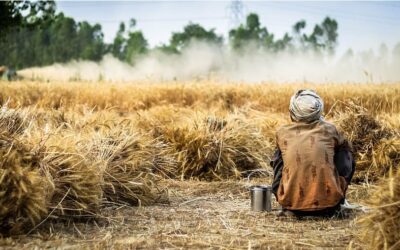Earth Day – Rising to the challenge of saving ourselves

“I want to leave the land in better condition than when I found it.
I want to create more using less, with less impact on the environment”
– Jay Schultz
As I was about to deliver my speech at the Private Sector Mechanism of the Committee on Food Security promoted by Food and Agriculture Organization (FAO) about how tree crops such as Cashew can move us closer to achieving multiple sustainable development goals, I was struck by the progress we have been able to achieve over the past few decades. We have moved a long way from just making people aware about environmental degradation due to human activities to reducing our footprint to now planning to reverse the degradation through various interventions such as tree crops. Even the Earth Day this year had a theme that looked at identifying and implementing solutions to reverse the impact of climate change.
Celebrated every year on 22 April, the theme for the 52nd Earth Day in 2022 was “Invest in our Planet”. This was a marked shift from the more generic “Restore our Earth” theme of 2021. The focus was on accelerating solutions to combat climate change, and to activate everyone – governments, citizens and especially businesses – to do their part through tangible investments, not just in reducing emissions but also in soaking up carbon from the atmosphere. Realization has dawned across countries that climate change is not two generations down the line but is already here. Every year, over the past few years, there have been instances of unprecedented calamities, be it the polar vortex in 2020 over North America, floods in China in 2021, heat waves in South Asia in 2022, forest fires in Australia and the USA, and more recently floods in South Africa.
This anthropogenic climate change has affected Africa disproportionately. As per Food Policy Research Institute (FPRI) estimates, all the remaining African glaciers would have melted over the next few decades causing water shortages, affecting agricultural production and precipitating population displacements. It also highlights that temperatures in Africa will likely rise 1.5 times higher as compared to the rest of the world by end of 21st century, resulting in droughts in some areas and floods in others. High levels of poverty, dependence on rainfall for agricultural production, weak or missing infrastructure, and lack of social safety nets in Africa can result in higher incidences of losses through such disasters.
Among the many solutions that were in focus / were proposed during the Earth Day Climate Action Summit (2022), was the need to pursue regenerative agriculture, especially relevant in the African context. Integration of perennials, herbs and crops that result in healthy carbon-sequestered soils is termed as ecologically beneficial regenerative agriculture. As per some experts, we only have 60 harvests left before we face full degradation of the topsoil, causing food scarcity, eventually leading to food riots. Instead of aiming for carbon-neutral agriculture, the target can be carbon-positive agriculture if regenerative agriculture is pursued. Not breaking the soil, planting cover crops, and using livestock for manure, are ways to achieve carbon-positive agriculture, ensuring healthy soil microbiome, while also improving profitability of the farmers. We can also increase the soil organic material by planting tree crops such as cashew interspersed with the food crops. For example, each cashew tree sheds 15-20 kgs of leaves every year that can contribute to improved organic content in the soil. As per some estimates, 1% increase in soil organic material can result in 5-10 tons of carbon capture per acre and 90,000 litres of water holding capacity. While increasing the yield, these practices have also allowed farmers to grow three crops annually instead of one crop, thereby increasing their incomes multi-fold, while improving their family’s health. Further, carbon sequestered in this manner can also bring additional revenues to the farmers through sale of these carbon credits on exchanges.
A systemic approach to farming is the way to ensure sustainable agriculture. It starts with caring for water, soil and food crops, and includes healthcare and education for the farmers and their families, energy availability, economics of operations, and also policy making. Policy making is especially critical as incentives need to be provided to farmers to do the right thing – not undertaking monocropping, intercropping with legumes, minimal use of fertilizer, optimal drawing of water for crops, etc. This will in turn result in a win-win-win for the farmer, community and businesses. While great initiatives are pursued at individual farm or community level, there is a lack of scale in replicating these models across vast swathes of farmland. Policy driven scaling of these models is another aspect that one needs to look at, to quickly move towards sustainable, regenerative and planet saving agriculture.
A note of caution here: all these steps have to be taken in tandem rather than piecemeal in order to achieve the desired results. Abrupt policy changes, without a corresponding change in water and soil management practices, can be disastrous. The sudden shift to organic agriculture by Sri Lanka, without ensuring the establishment of necessary supporting infrastructure, resulted in economic hardship for the entire country in 2022.
At EFF, we are closely working with African farmers to promote sustainable agriculture, while ensuring that it doesn’t hamper the incomes of farmers. We are looking at increasing farmer incomes by promoting tree crops such as cashew intercropped with cover crops such as finger millet, and other short-term income generating crops such as groundnuts. These tree crops and cover crops restore organic content in the soil that further enhance the yield of the food crops for the farmers. We have already planted more than 6 million cashew saplings in Zambia over the last three years and plan to continue with this pace over the next 3-5 years. To further incentivize the farmers towards these tree crops, we are collaborating with partners to develop a carbon credit system that will result in additional income for the farmers. By investing our resources for these activities, we hope to leave a better world for our coming generations.
Continue Reading
World Environment Day – Revisiting “Only One Earth”
Climate change is real. It affects developing nations disproportionately as compared to developed nations. Developing nations should not wait for help to do good for the environment but work towards ensuring that these challenges are met headlong. They should know that sustainability goals and development is not mutually exclusive.
World Food Crisis – How Africa can be the long-term solution
Africa has abundant resources to be the food factory for the world. This holds true especially for vegetable oil crops such as Sunflower, palm, soybean and rapeseed. Tanzania provides ideal conditions for growing sunflower at scale and supply it’s oil to the major consuming nations such as India.
Agritech Innovations from India: Relevance in the African context
Agricultural Innovations showcased in fares across the developing world can be a good place to look for solving Africa’s challenges.




0 Comments